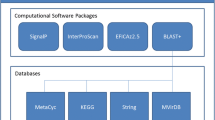Abstract
Selenoproteins contain selenocysteine (Sec or U), the 21st amino acid, inserted in response to an in-frame UGA codon. UGA normally terminates translation, but in selenoprotein mRNAs it is recoded to specify Sec insertion. For this reason, standard gene prediction programs fail to predict Sec codons, and selenoproteins are usually misannotated in protein databases and genome projects. Selenoprofiles is a computational pipeline able to correctly annotate selenoprotein genes in genomic sequences. This program uses a SECIS-independent approach, based on homology searches, and employs curated built-in profile alignments for all known selenoprotein families. Selenoprofiles constitutes the most accurate method for predicting selenoprotein genes belonging to known families.
Access this chapter
Tax calculation will be finalised at checkout
Purchases are for personal use only
Similar content being viewed by others
References
Driscoll DM, Chavatte L (2004) Finding needles in a haystack. In silico identification of eukaryotic selenoprotein genes. EMBO Rep 5:140–141. doi:10.1038/sj.embor.7400080
Berry MJ, Banu L, Chen YY et al (1991) Recognition of UGA as a selenocysteine codon in type I deiodinase requires sequences in the 3′ untranslated region. Nature 353:273–276. doi:10.1038/353273a0
Mariotti M, Guigó R (2010) Selenoprofiles: profile-based scanning of eukaryotic genome sequences for selenoprotein genes. Bioinformatics 26:2656–2663. doi:10.1093/bioinformatics/btq516
Mariotti M (2016) Selenoprofiles 3 | Bioinformatics and Genomics @ CRG http://big.crg.cat/services/selenoprofiles. Accessed 1 Nov 2016
Altschul SF, Madden TL, Schäffer AA et al (1997) Gapped BLAST and PSI-BLAST: a new generation of protein database search programs. Nucleic Acids Res 25:3389–3402
Slater GSC, Birney E (2005) Automated generation of heuristics for biological sequence comparison. BMC Bioinformatics 6:31. doi:10.1186/1471-2105-6-31
Birney E, Clamp M, Durbin R (2004) GeneWise and Genomewise. Genome Res 14:988–995. doi:10.1101/gr.1865504
Katoh K, Misawa K, Kuma K, Miyata T (2002) MAFFT: a novel method for rapid multiple sequence alignment based on fast Fourier transform. Nucleic Acids Res 30:3059–3066. doi:10.1093/nar/gkf436
Mariotti M, Lobanov A V, Guigo R, Gladyshev VN (2013) SECISearch3 and Seblastian: new tools for prediction of SECIS elements and selenoproteins. Nucleic Acids Res 41:e149. doi:10.1093/nar/gkt550
Notredame C, Higgins DG, Heringa J (2000) T-coffee: a novel method for fast and accurate multiple sequence alignment. J Mol Biol 302:205–217. doi:10.1006/jmbi.2000.4042
Author information
Authors and Affiliations
Corresponding author
Editor information
Editors and Affiliations
Rights and permissions
Copyright information
© 2018 Springer Science+Business Media LLC
About this protocol
Cite this protocol
Santesmasses, D., Mariotti, M., Guigó, R. (2018). Selenoprofiles: A Computational Pipeline for Annotation of Selenoproteins. In: Chavatte, L. (eds) Selenoproteins. Methods in Molecular Biology, vol 1661. Humana Press, New York, NY. https://doi.org/10.1007/978-1-4939-7258-6_2
Download citation
DOI: https://doi.org/10.1007/978-1-4939-7258-6_2
Published:
Publisher Name: Humana Press, New York, NY
Print ISBN: 978-1-4939-7257-9
Online ISBN: 978-1-4939-7258-6
eBook Packages: Springer Protocols




